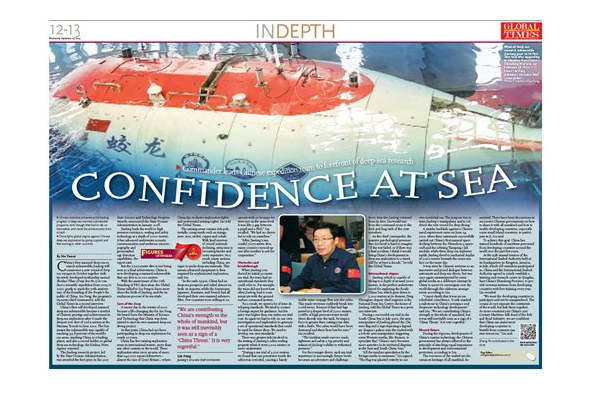- HOME
- ABOUT US
- NEWS
- ACHIEVEMENT
- PICTURE
- VIDEO
- CHINESE VERSION
- CONTACT US
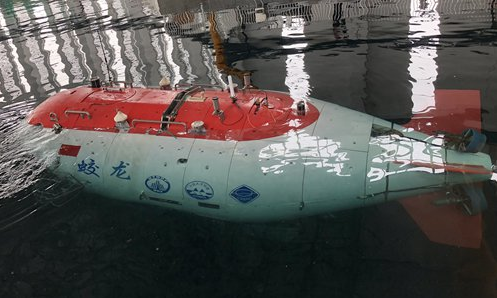
Manned deep-sea research submersible Jiaolong goes on its first dive trial after upgrading in Qingdao, East China's Shandong Province, on February 28. Photo: VCG
Chinese scientists achieved world-leading progress in deep-sea manned submersible programs, even though they had to rely on themselves and made the achievements from scratch
China fights global stigma against Chinese deep-sea exploration by giving support and free training to other countries
China's first manned deep-sea research submersible Jiaolong will commence a new round of deep-sea voyages in October together with its newly developed mothership named Shenhai Yihao (Deep Sea No.1) to conduct a scientific expedition from 2019 to 2020, partly to mark the 70th anniversary of the founding of the People's Republic of China, Liu Feng, the program's on-scene chief commander, told the Global Times in a recent interview.
China's first self-developed manned deep-sea submersible became a symbol of Chinese prestige and achievement in deep-sea exploration after it made the deepest ever dive of 7,062 meters at the Mariana Trench in June 2012. The feat meant the submersible was capable of reaching 99.8 percent of the world's sea areas, marking China as a leading player, and also a record holder, in global deep-sea technology, the Xinhua News Agency reported.
The Jiaolong research project, led by the State Oceanic Administration, was awarded the first prize in the 2017 State Science and Technology Progress Awards, announced the State Oceanic Administration in January 2018.
Jiaolong leads the world in high pressure resistance, sealing and safety technology at a depth of 7,000 meters. It has advanced underwater acoustic communication and undersea microtopography and geomorphology detection capabilities, the report said.
But the 7,000-meter dive is not being seen as a final achievement. China is now developing a manned submersible that can dive to 11,000 meters.
With the anniversary of the 70th founding of PRC days away, the Global Times talked to Liu Feng to learn more about the birth of Jiaolong, and the tumultuous process of its sea trials.
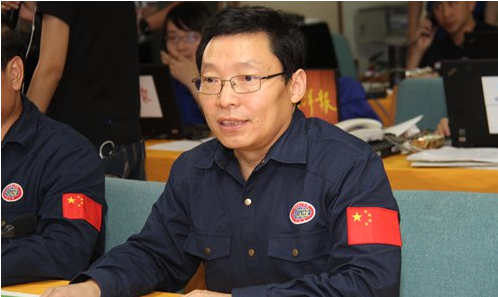
Liu Feng, Jiaolong's on-scene chief commander Photo: Courtesy of Liu Feng
Lure of the deep
A snowy day in the winter of 2001 became a life-changing day for Liu Feng. He heard from the Ministry of Science and Technology that China was determined to start its own manned deep-sea diving project.
At that point, China had not been participating in deep-sea exploration for nearly 50 years.
China has five mining exploration areas in international waters, more than any other country in the world. These exploration sites cover an area of more than 240,000 square kilometers - almost the size of Great Britain - where China has exclusive exploration rights and preferential mining rights, Liu told the Global Times.
The mining areas contain rich polymetallic compounds such as manganese, iron, nickel, copper and cobalt. With land reserves of crucial minerals declining, extraction is becoming harder and more expensive. As a result, many nations, including China, are eager to probe deep-sea minerals. This means advanced equipment is then required for sophisticated exploration, said Liu.
"In the early 1990s, China had no deep-sea prospects and relied almost entirely on imports, while the Americans, Japanese, Russians, and French had all developed their own manned submersibles. Few countries were willing to cooperate with us because we were not on the same level. It was like a gap between a pupil and a PhD," Liu recalled."We had no choice but to rely on ourselves."
"After Jiaolong's successful 7,000-meter dive, many countries turned up one after another to ask for cooperation."
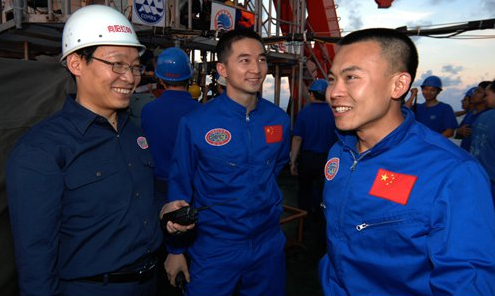
Liu Feng encourages the submersible crew before the sea trial dive of 7,000 meters in 2012. Photo: Courtesy of Liu Feng
Obstacles and breakthrough
When Jiaolong conducted its initial 50-meter sea trial, the team had no operational standards they could refer to. For example, the team did not know how often Jiaolong had to communicate with the ground surface command system.
"As a result, we spent a lot of time developing standards. We tried to contact a foreign expert for guidance, but his price was higher than our entire sea trial cost. So again we had to rely on our own investigation and exploration to generate a set of operational standards that could be used for future dives. We need to develop our own standards."
There was greater risk involved in the testing of Jiaolong's cabin sealing property when it went 3,000 meters or more underwater.
"During a sea trial of 3,000 meters, we found that one penetrator inside the cabin was corroded, causing a barely visible water seepage flow into the cabin. This made everyone suddenly break into a cold sweat. Because if that had happened at a deeper level of 7,000 meters, 70MPa of high pressure water would shoot directly into the tank. Its impact force is greater than cutting your skin with a knife. The cabin would have been destroyed and three lives lost for sure," Liu recalled.
"The incident made sure we made tightness and safety a top priority and enhanced Jiaolong's ability to withstand pressure."
For the younger divers, each sea trial experience at increasingly deeper levels becomes an adventure and challenge. Every time the Jiaolong returned from its dive, Liu would run from the command room to the deck and hug each of the crew members.
As the chief commander, the massive psychological pressure that Liu faced is hard to imagine."If the test failed, or if there was a fatal accident, I think it would bring China's development in deep-sea exploration to a standstill for at least a decade," he told the Global Times.
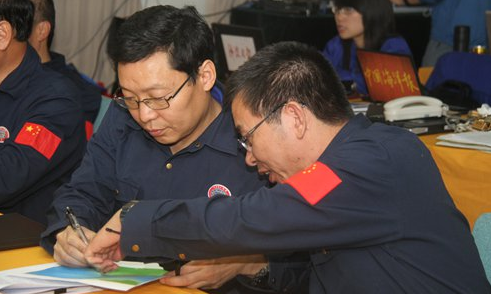
Liu Feng discusses problems with deputy commander of Jiaolong, Cui Weicheng, during the sea trial in 2012. Photo: Courtesy of Liu Feng
International stigma
Jiaolong, which is capable of diving to a depth of around 7,000 meters, is the perfect underwater vessel for exploring the South China Sea, which goes down to 5,000 meters at its deepest, Ding Zhongjun, deputy chief engineer at the National Deep Sea Center, the home of Jiaolong, told the Global Times in a previous interview.
During a successful sea trial in the South China Sea in July 2010, the arm manipulator of Jiaolong placed the Chinese flag and a sign depicting a legendary dragon's palace onto the seabed with a robotic arm manipulator, triggering some Western media, like Reuters, to speculate that"China's navy becomes more assertive in its territorial disputes in the East and South China Seas."
"All the random speculation by the foreign media is nonsense," Liu argued,"The flag was planted entirely in our own territorial sea. The purpose was to train Jiaolong's manipulator and to celebrate the new record for deep diving."
A similar backlash against a Chinese naval experiment came on June 24, 2012, when three astronauts successfully carried out China's first manual space docking between the Shenzhou-9 spacecraft and the orbiting Tiangong-1 lab module, while three deep-sea explorers inside Jiaolong dived to uncharted depths of 7,020 meters beneath the ocean surface on the same day.
It was seen by Chinese netizens as an innovative and proud dialogue between astronauts and deep-sea divers, but was once again misinterpreted by some global media as a deliberate attempt by China to assert its sovereignty over the world through this elaborate arrangement, according to Liu.
"I must clarify that it was an unscheduled coincidence. It only marked a milestone in China's aerospace and deepwater technology development," said Liu."We are contributing China's strength to the whole of mankind, but it was still inevitably seen as a sign of a'China Threat.' It is very regretful."
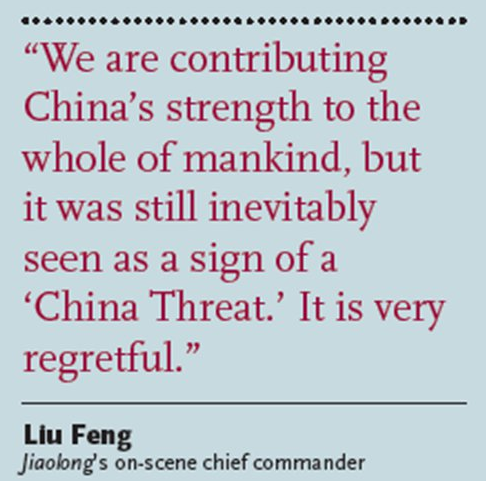
Shared future
During the vigorous development of China's marine technology, the Chinese government has always adhered to the principle of attaching equal importance to development and environmental protection, according to Liu.
The resources of the seabed are the common heritage of all mankind, he asserted. There have been discussions in successive Chinese governments on how to share it with all mankind and how to enable developing countries, especially some small island countries, to participate in it, Liu said.
To achieve this goal, China has trained hundreds of maritime personnel from developing countries around the world over the past few years.
At the 25th annual session of the International Seabed Authority held at its headquarters in Kingston, Jamaica, in July, which 168 members participated in, China and the International Seabed Authority agreed to jointly establish a training and research center in Qingdao, East China's Shandong Province, to provide overseas trainees from developing countries with free training every year, Liu revealed.
"We want the developing countries to participate and not be marginalized. The oceans do not separate the continents of the world, but link them together. As more countries join China's 21st Century Maritime Silk Road of the Belt and Road Initiative, we are confident that China can assist more developing countries to benefit from common marine resources," Liu said.
Zhang Ni contributed to the story
